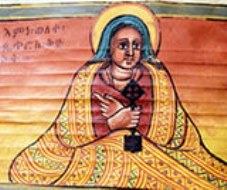Classic DACB Collection
All articles created or submitted in the first twenty years of the project, from 1995 to 2015.Walatta Petros (A)

Saint Walata Petros (1594-November 24, 1643), one of the few women saints in Ethiopian hagiography, played a leading role in the anti-Catholic struggle waged by Ethiopian Monophysites (believers in the doctrine that the human and divine elements in Jesus Christ were unified by a single nature) during the reign of Emperor Susneyos (1607-32).
Her anonymous biographer relates that she was born in 1594, the daughter of a lady named Krestos Ebaya and of a nobleman of Dawaro and Fatajar (east of Shawa) named Baher Saggad. Walata Petros became the wife of one of the leading personalities of the reign of Susneyos, Malkea Krestos. She was, however, indifferent both to her husband’s love and to the wealth that he gave her, since, from her youth, she had longed for the religious life. When the Jesuit missionaries and the Ethiopian Orthodox clergy first began their quarrel, Walata Petros wholeheartedly supported the Orthodox cause. Her husband prevented her first attempt to retire to a convent. But after the rebellion of Yolyos, the son-in-law of Susneyos, in May 1617, in which both Yolyos and the Coptic Metropolitan, Abuna Semeon, were killed, the religious conflict entered a new and bitter phase, and, at the age of 24, Walata Petros resolved to end her marriage. Gathering about her a small group of likeminded women, including her most devoted followers, Walata Krestos and Eheta Krestos, she retired to Waldebba (about 90 mi, or 150 km, north of Gondar), which was famous as the home of hermits and anchorites.
The anti-Catholic activities of Walata Petros and her followers led Susneyos to summon them to court to answer charges brought against them. A long period of persecution and confinement followed, during which Walata Petros and her disciples refused all efforts by the Catholic Patriarch, Bishop Affonso Mendez, and others to convert them to Catholicism. Susneyos then ordered Walata Petros to be exiled to Jabal on the western frontier of Ethiopia. There she suffered every form of persecution and indignity with such courage that the guard allowed her to gather groups of people around her and teach them.
Thus she established at Jabal the first of the seven religious communities that she was to found, in accordance with a prophecy made when she first retired to Waldebba. Eventually, the anti-Catholic movement gained strength at court, and Walata Petros was allowed to return to the Lake Tana area where she founded the two communities of Chenqwa and Mesela.
In 1632, Susneyos finally abandoned the bitter struggle to impose the Roman Catholic faith in Ethiopia. Shortly afterwards he died, and was succeeded by his son Fasilidas (reigned 1632-67). The new emperor restored the Ethiopian Monophysite faith, and Walata Petros was honored and revered as a popular heroine for her long resistance to Catholicism. But instead of retiring to the calm, contemplative life of some sheltered cloister in the last 12 years of her life, she travelled the country, teaching with renewed zeal, gathering new disciples, and founding new religious communities. She died on November 24, 1643, after naming her constant companion, Eheta Krestos, as her successor, and was buried on the holy island of Rema near the southeast shore of Lake Tana.
Belaynesh Michael
Bibliography
Guidi, Annales regum Iyasu II et Iyo’as (“Annals of Kings Iyasu II and Iyoas”), Paris, 1910, Louvain, 1954.
G. Nollet, “La legende de Ehta-Krestos” (“The Legend of Eheta Krestos”), Aethiops Bulletin Ge’ez, Paris, 1930.
M.S. Papi, “Una santa abissinia anticattolica, Walata-Petros” (“An Anti-Catholic Saint, Walata Petros”), Vol. 3, Rome, 1943.
L. Ricci, Vita di Walatta Petros (“Life of Walata Petros”), Louvain, 1970.
This article was reprinted from The Encyclopaedia Africana Dictionary of African Biography (in 20 Volumes). Volume One Ethiopia-Ghana, Ed. L. H. Ofosu-Appiah. New York: Reference Publications Inc., 1977. All rights reserved. This article also appeared in the June 2016 issue of the Journal of African Christian Biography. Click here to read the Journal.



